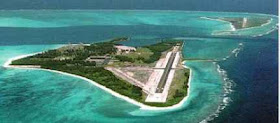In 1935, Italy invaded Abyssinia (Ethiopia). Abyssinia, a member of the League of Nations, appealed for help. The League, under the leadership of Great Britain, imposed sanctions on Italy. But the sanctions were only half-way. The importation of many commodities was prohibited, but oil, essential to the Italian war effort was permitted. Additionally, in the words of Winston Churchill:
The export of aluminium to Italy was strictly forbidden; but aluminium was almost the only metal that Italy produced in quantities beyond her own needs. The importation of scrap iron and iron ore into Italy was sternly vetoed in the name of public justice. But as the Italian metallurgical industry made but little use of them, and as steel billets and pig iron were not interfered with, Italy suffered no hindrance. Thus the measures pressed with so great a parade were not real sanctions to paralyse the aggressor, but merely such halfhearted sanctions as the aggressor would tolerate, because in fact, though onerous, they stimulated Italian war spirit. The League of Nations therefore proceeded to the rescue of Abyssinia on the basis that nothing must be done to hamper the invading Italian armies. (Churchill, Memoirs of the Second World War)
The British navy, which could easily have stopped the Italians, did not lift a finger to stop them. Italy conquered Abyssinia, gained prestige, and joined an alliance with Hitler. Britain was held in contempt across Europe. Hitler viewed Britain as weak and degenerate and continued his preparations for World War II with increased boldness. The half-halfheartedness of the British government in that endeavor brought the nation nothing but trouble and disgrace. Halfhearted measures are never good enough. If anything is to be done, it must be done wholeheartedly.
Several Bible verses support this conclusion:
"Jesus said unto him, No man having put his hand to the plough,
and looking back, is fit for the kingdom of God." --Luke 9:62
" For which of you, intending to build a tower, sitteth not down first, and counteth the cost, whether he have sufficient to finish it? Lest haply, after he hath laid the foundation, and is not able to finish it, all that behold begin to mock him, Saying, This man began to build, and was not able to finish." --Luke 14:28-30
"And whatsoever ye do, do it heartily, as to the Lord, and not unto men..." --Colossians 3:23
Don't start something unless you can and will complete it. You can do almost anything if you really set your heart on getting it done, and completion--finishing a project--will always give you a sense of satisfaction. It will do you a lot of good both materially and emotionally to get even one project done.
Of course, if you make the mistake of starting a bad project, quit it and move on to another as quickly as possible. But starting 100 projects and not finishing any of them will do you no good. It will just be a waste of time. Unfortunately, that is exactly what a lot of people do.
They start reading one book, and before they finish it, they get bored and start another. Before their lives are over they may have 50 books that they've started and never finished. Unless they are "Preface" fans, what good did it do them? It's a clear road to ignorance.
They start several sewing projects and handi-work projects (knitting, crocheting) at once and can never finish them all. What good is a half-finished sweater, plus a half-finished scarf, plus a half-finished skirt going to do them on a cold day? I think they will be shivering.
They start learning languages and never complete their studies. What good does it do anyone to say a sentence in a mixture of English, German, Thai, Russian, French, and Spanish? They would be better off sticking with one or two languages.
And have you ever tried to eat a half-baked cake? Half-cooked meat-loaf? Half-done Jello? What good would it do you? Don't try, you'd get very sick.
Don't be like those whom I mentioned above.
Sure, it makes sense that as soon as you realize you're on the wrong road, stop! Stop and immediately change your course to the right course before it's too late. We all make mistakes.
But if life is just a bunch of half-hearted, half-completed projects, we have gotten nowhere. We have completed nothing.
Whatever we do, we must do it wholeheartedly and diligently as unto the Lord because we are servants of the Lord Jesus Christ who gives us strength even in our weaknesses.
Let me get back to work on that scarf I'm crocheting... God bless you all!



















_during_Battle_of_Midway.jpg)











_at_the_New_York_Navy_Yard.jpg)
